Managing Financial Resources and Decision Making for Aston Ltd
VerifiedAdded on 2020/12/18
|18
|4611
|151
Report
AI Summary
This report delves into the critical aspects of financial resource management and decision-making within a business context. It begins by identifying potential funding sources, such as equity share capital, bank loans, retained profits, and factoring, evaluating their advantages and disadvantages, and analyzing associated costs. The report emphasizes the significance of financial planning for achieving business goals and mitigating financial risks. It then examines investment appraisal techniques, specifically the Net Present Value (NPV) method, to assess the viability of capital projects, like the proposed investment by Aston Ltd. The report includes a detailed NPV calculation, along with an analysis of the weighted average cost of capital (WACC). Furthermore, the report explores the purpose and formats of financial statements, assessing the financial performance of Tesco Plc. Finally, the report discusses the informational needs of key stakeholders, including business owners, financial institutions, and shareholders, highlighting how they use financial statements to make informed decisions.

Managing Financial Resources and Decision
Making
Making
Paraphrase This Document
Need a fresh take? Get an instant paraphrase of this document with our AI Paraphraser
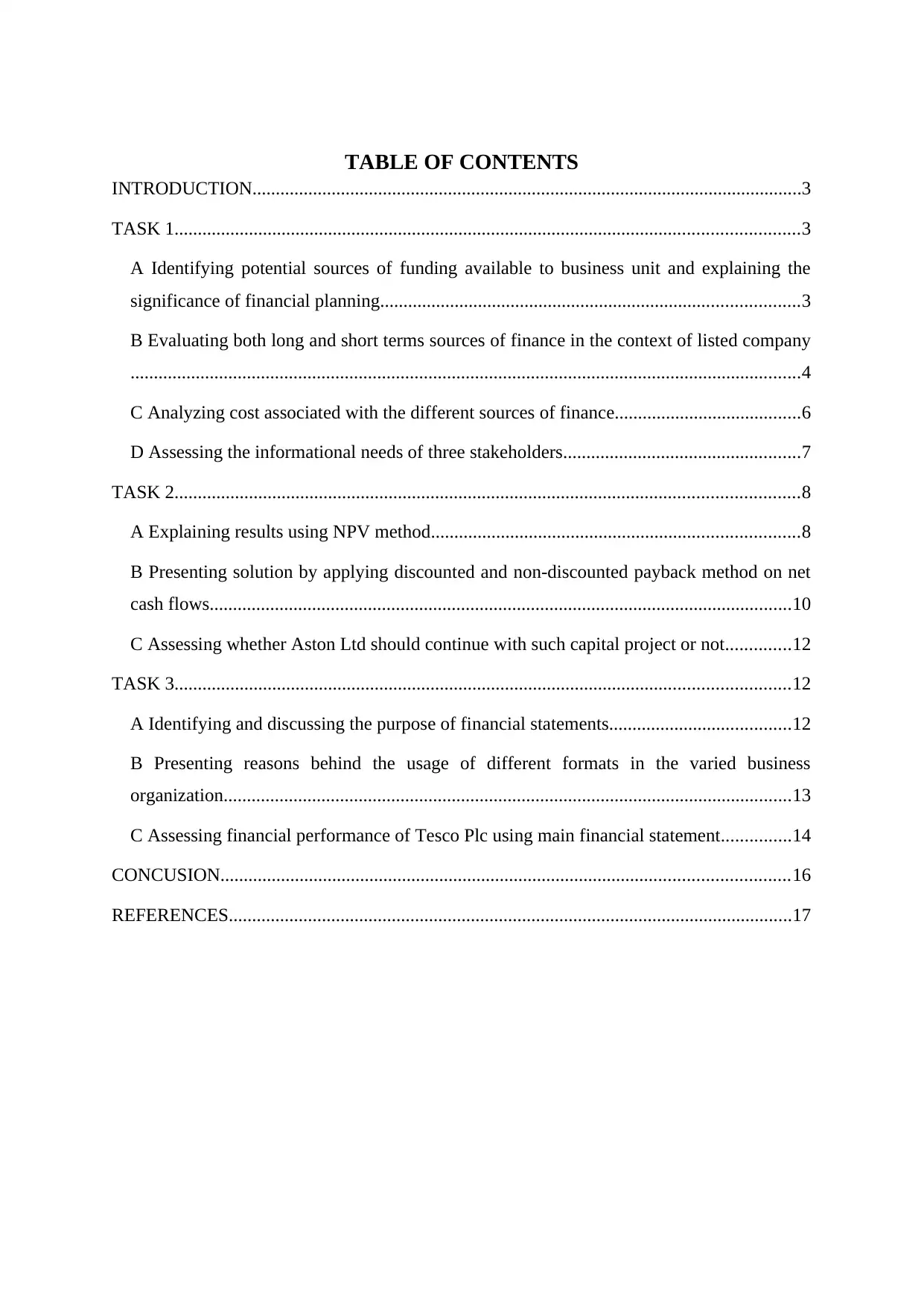
TABLE OF CONTENTS
INTRODUCTION......................................................................................................................3
TASK 1......................................................................................................................................3
A Identifying potential sources of funding available to business unit and explaining the
significance of financial planning..........................................................................................3
B Evaluating both long and short terms sources of finance in the context of listed company
................................................................................................................................................4
C Analyzing cost associated with the different sources of finance........................................6
D Assessing the informational needs of three stakeholders...................................................7
TASK 2......................................................................................................................................8
A Explaining results using NPV method...............................................................................8
B Presenting solution by applying discounted and non-discounted payback method on net
cash flows.............................................................................................................................10
C Assessing whether Aston Ltd should continue with such capital project or not..............12
TASK 3....................................................................................................................................12
A Identifying and discussing the purpose of financial statements.......................................12
B Presenting reasons behind the usage of different formats in the varied business
organization..........................................................................................................................13
C Assessing financial performance of Tesco Plc using main financial statement...............14
CONCUSION..........................................................................................................................16
REFERENCES.........................................................................................................................17
INTRODUCTION......................................................................................................................3
TASK 1......................................................................................................................................3
A Identifying potential sources of funding available to business unit and explaining the
significance of financial planning..........................................................................................3
B Evaluating both long and short terms sources of finance in the context of listed company
................................................................................................................................................4
C Analyzing cost associated with the different sources of finance........................................6
D Assessing the informational needs of three stakeholders...................................................7
TASK 2......................................................................................................................................8
A Explaining results using NPV method...............................................................................8
B Presenting solution by applying discounted and non-discounted payback method on net
cash flows.............................................................................................................................10
C Assessing whether Aston Ltd should continue with such capital project or not..............12
TASK 3....................................................................................................................................12
A Identifying and discussing the purpose of financial statements.......................................12
B Presenting reasons behind the usage of different formats in the varied business
organization..........................................................................................................................13
C Assessing financial performance of Tesco Plc using main financial statement...............14
CONCUSION..........................................................................................................................16
REFERENCES.........................................................................................................................17
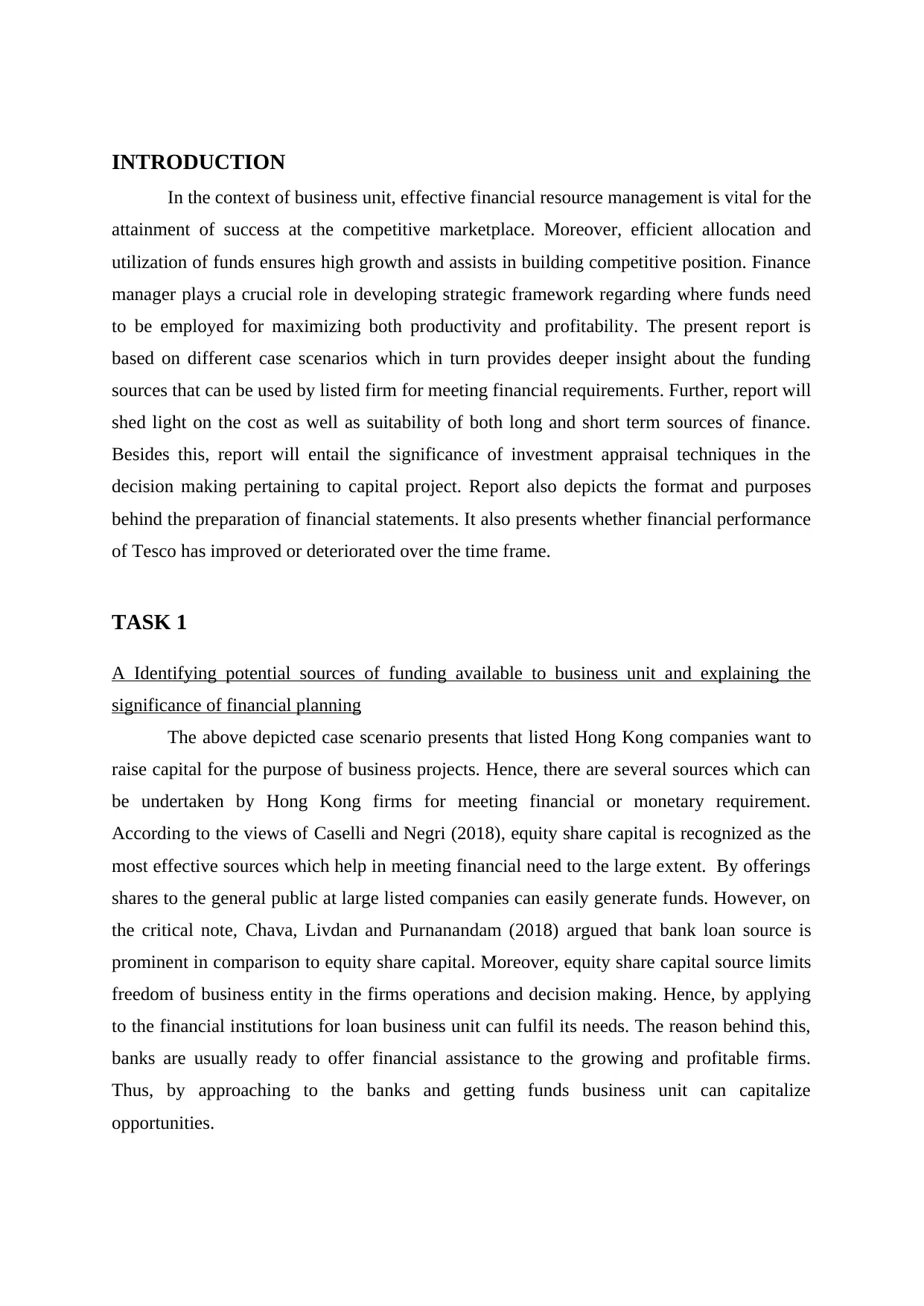
INTRODUCTION
In the context of business unit, effective financial resource management is vital for the
attainment of success at the competitive marketplace. Moreover, efficient allocation and
utilization of funds ensures high growth and assists in building competitive position. Finance
manager plays a crucial role in developing strategic framework regarding where funds need
to be employed for maximizing both productivity and profitability. The present report is
based on different case scenarios which in turn provides deeper insight about the funding
sources that can be used by listed firm for meeting financial requirements. Further, report will
shed light on the cost as well as suitability of both long and short term sources of finance.
Besides this, report will entail the significance of investment appraisal techniques in the
decision making pertaining to capital project. Report also depicts the format and purposes
behind the preparation of financial statements. It also presents whether financial performance
of Tesco has improved or deteriorated over the time frame.
TASK 1
A Identifying potential sources of funding available to business unit and explaining the
significance of financial planning
The above depicted case scenario presents that listed Hong Kong companies want to
raise capital for the purpose of business projects. Hence, there are several sources which can
be undertaken by Hong Kong firms for meeting financial or monetary requirement.
According to the views of Caselli and Negri (2018), equity share capital is recognized as the
most effective sources which help in meeting financial need to the large extent. By offerings
shares to the general public at large listed companies can easily generate funds. However, on
the critical note, Chava, Livdan and Purnanandam (2018) argued that bank loan source is
prominent in comparison to equity share capital. Moreover, equity share capital source limits
freedom of business entity in the firms operations and decision making. Hence, by applying
to the financial institutions for loan business unit can fulfil its needs. The reason behind this,
banks are usually ready to offer financial assistance to the growing and profitable firms.
Thus, by approaching to the banks and getting funds business unit can capitalize
opportunities.
In the context of business unit, effective financial resource management is vital for the
attainment of success at the competitive marketplace. Moreover, efficient allocation and
utilization of funds ensures high growth and assists in building competitive position. Finance
manager plays a crucial role in developing strategic framework regarding where funds need
to be employed for maximizing both productivity and profitability. The present report is
based on different case scenarios which in turn provides deeper insight about the funding
sources that can be used by listed firm for meeting financial requirements. Further, report will
shed light on the cost as well as suitability of both long and short term sources of finance.
Besides this, report will entail the significance of investment appraisal techniques in the
decision making pertaining to capital project. Report also depicts the format and purposes
behind the preparation of financial statements. It also presents whether financial performance
of Tesco has improved or deteriorated over the time frame.
TASK 1
A Identifying potential sources of funding available to business unit and explaining the
significance of financial planning
The above depicted case scenario presents that listed Hong Kong companies want to
raise capital for the purpose of business projects. Hence, there are several sources which can
be undertaken by Hong Kong firms for meeting financial or monetary requirement.
According to the views of Caselli and Negri (2018), equity share capital is recognized as the
most effective sources which help in meeting financial need to the large extent. By offerings
shares to the general public at large listed companies can easily generate funds. However, on
the critical note, Chava, Livdan and Purnanandam (2018) argued that bank loan source is
prominent in comparison to equity share capital. Moreover, equity share capital source limits
freedom of business entity in the firms operations and decision making. Hence, by applying
to the financial institutions for loan business unit can fulfil its needs. The reason behind this,
banks are usually ready to offer financial assistance to the growing and profitable firms.
Thus, by approaching to the banks and getting funds business unit can capitalize
opportunities.
⊘ This is a preview!⊘
Do you want full access?
Subscribe today to unlock all pages.

Trusted by 1+ million students worldwide
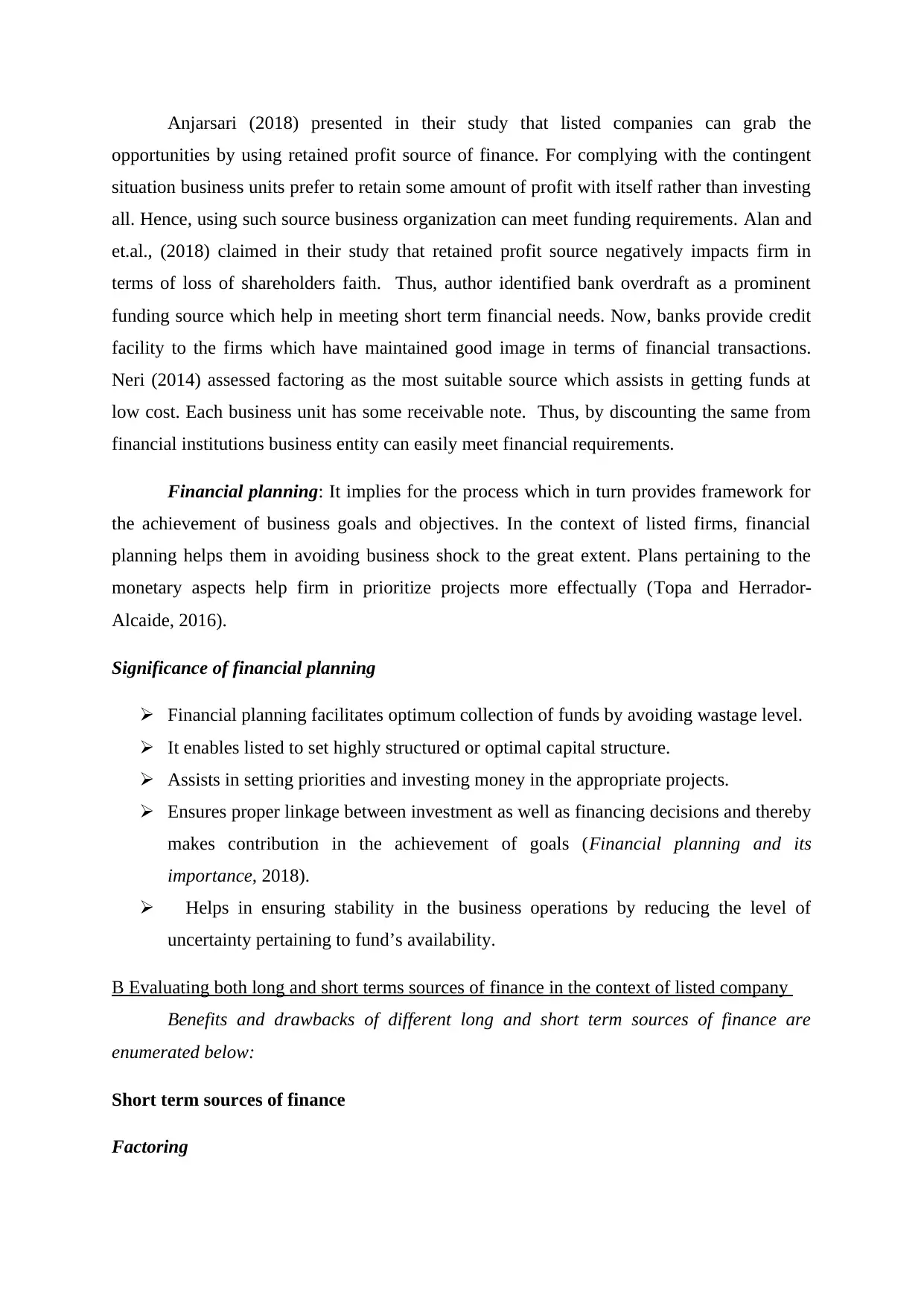
Anjarsari (2018) presented in their study that listed companies can grab the
opportunities by using retained profit source of finance. For complying with the contingent
situation business units prefer to retain some amount of profit with itself rather than investing
all. Hence, using such source business organization can meet funding requirements. Alan and
et.al., (2018) claimed in their study that retained profit source negatively impacts firm in
terms of loss of shareholders faith. Thus, author identified bank overdraft as a prominent
funding source which help in meeting short term financial needs. Now, banks provide credit
facility to the firms which have maintained good image in terms of financial transactions.
Neri (2014) assessed factoring as the most suitable source which assists in getting funds at
low cost. Each business unit has some receivable note. Thus, by discounting the same from
financial institutions business entity can easily meet financial requirements.
Financial planning: It implies for the process which in turn provides framework for
the achievement of business goals and objectives. In the context of listed firms, financial
planning helps them in avoiding business shock to the great extent. Plans pertaining to the
monetary aspects help firm in prioritize projects more effectually (Topa and Herrador-
Alcaide, 2016).
Significance of financial planning
Financial planning facilitates optimum collection of funds by avoiding wastage level.
It enables listed to set highly structured or optimal capital structure.
Assists in setting priorities and investing money in the appropriate projects.
Ensures proper linkage between investment as well as financing decisions and thereby
makes contribution in the achievement of goals (Financial planning and its
importance, 2018).
Helps in ensuring stability in the business operations by reducing the level of
uncertainty pertaining to fund’s availability.
B Evaluating both long and short terms sources of finance in the context of listed company
Benefits and drawbacks of different long and short term sources of finance are
enumerated below:
Short term sources of finance
Factoring
opportunities by using retained profit source of finance. For complying with the contingent
situation business units prefer to retain some amount of profit with itself rather than investing
all. Hence, using such source business organization can meet funding requirements. Alan and
et.al., (2018) claimed in their study that retained profit source negatively impacts firm in
terms of loss of shareholders faith. Thus, author identified bank overdraft as a prominent
funding source which help in meeting short term financial needs. Now, banks provide credit
facility to the firms which have maintained good image in terms of financial transactions.
Neri (2014) assessed factoring as the most suitable source which assists in getting funds at
low cost. Each business unit has some receivable note. Thus, by discounting the same from
financial institutions business entity can easily meet financial requirements.
Financial planning: It implies for the process which in turn provides framework for
the achievement of business goals and objectives. In the context of listed firms, financial
planning helps them in avoiding business shock to the great extent. Plans pertaining to the
monetary aspects help firm in prioritize projects more effectually (Topa and Herrador-
Alcaide, 2016).
Significance of financial planning
Financial planning facilitates optimum collection of funds by avoiding wastage level.
It enables listed to set highly structured or optimal capital structure.
Assists in setting priorities and investing money in the appropriate projects.
Ensures proper linkage between investment as well as financing decisions and thereby
makes contribution in the achievement of goals (Financial planning and its
importance, 2018).
Helps in ensuring stability in the business operations by reducing the level of
uncertainty pertaining to fund’s availability.
B Evaluating both long and short terms sources of finance in the context of listed company
Benefits and drawbacks of different long and short term sources of finance are
enumerated below:
Short term sources of finance
Factoring
Paraphrase This Document
Need a fresh take? Get an instant paraphrase of this document with our AI Paraphraser
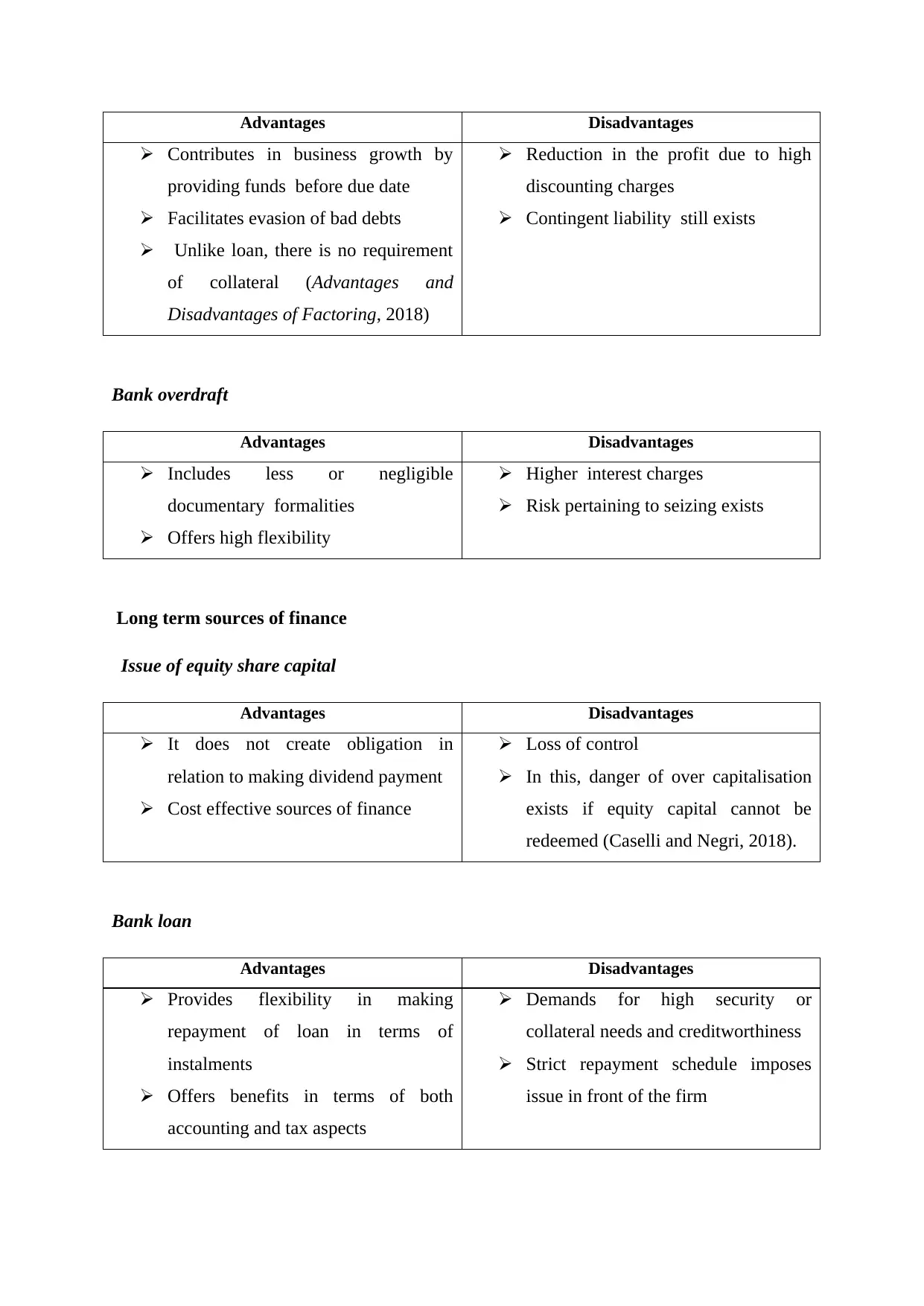
Advantages Disadvantages
Contributes in business growth by
providing funds before due date
Facilitates evasion of bad debts
Unlike loan, there is no requirement
of collateral (Advantages and
Disadvantages of Factoring, 2018)
Reduction in the profit due to high
discounting charges
Contingent liability still exists
Bank overdraft
Advantages Disadvantages
Includes less or negligible
documentary formalities
Offers high flexibility
Higher interest charges
Risk pertaining to seizing exists
Long term sources of finance
Issue of equity share capital
Advantages Disadvantages
It does not create obligation in
relation to making dividend payment
Cost effective sources of finance
Loss of control
In this, danger of over capitalisation
exists if equity capital cannot be
redeemed (Caselli and Negri, 2018).
Bank loan
Advantages Disadvantages
Provides flexibility in making
repayment of loan in terms of
instalments
Offers benefits in terms of both
accounting and tax aspects
Demands for high security or
collateral needs and creditworthiness
Strict repayment schedule imposes
issue in front of the firm
Contributes in business growth by
providing funds before due date
Facilitates evasion of bad debts
Unlike loan, there is no requirement
of collateral (Advantages and
Disadvantages of Factoring, 2018)
Reduction in the profit due to high
discounting charges
Contingent liability still exists
Bank overdraft
Advantages Disadvantages
Includes less or negligible
documentary formalities
Offers high flexibility
Higher interest charges
Risk pertaining to seizing exists
Long term sources of finance
Issue of equity share capital
Advantages Disadvantages
It does not create obligation in
relation to making dividend payment
Cost effective sources of finance
Loss of control
In this, danger of over capitalisation
exists if equity capital cannot be
redeemed (Caselli and Negri, 2018).
Bank loan
Advantages Disadvantages
Provides flexibility in making
repayment of loan in terms of
instalments
Offers benefits in terms of both
accounting and tax aspects
Demands for high security or
collateral needs and creditworthiness
Strict repayment schedule imposes
issue in front of the firm
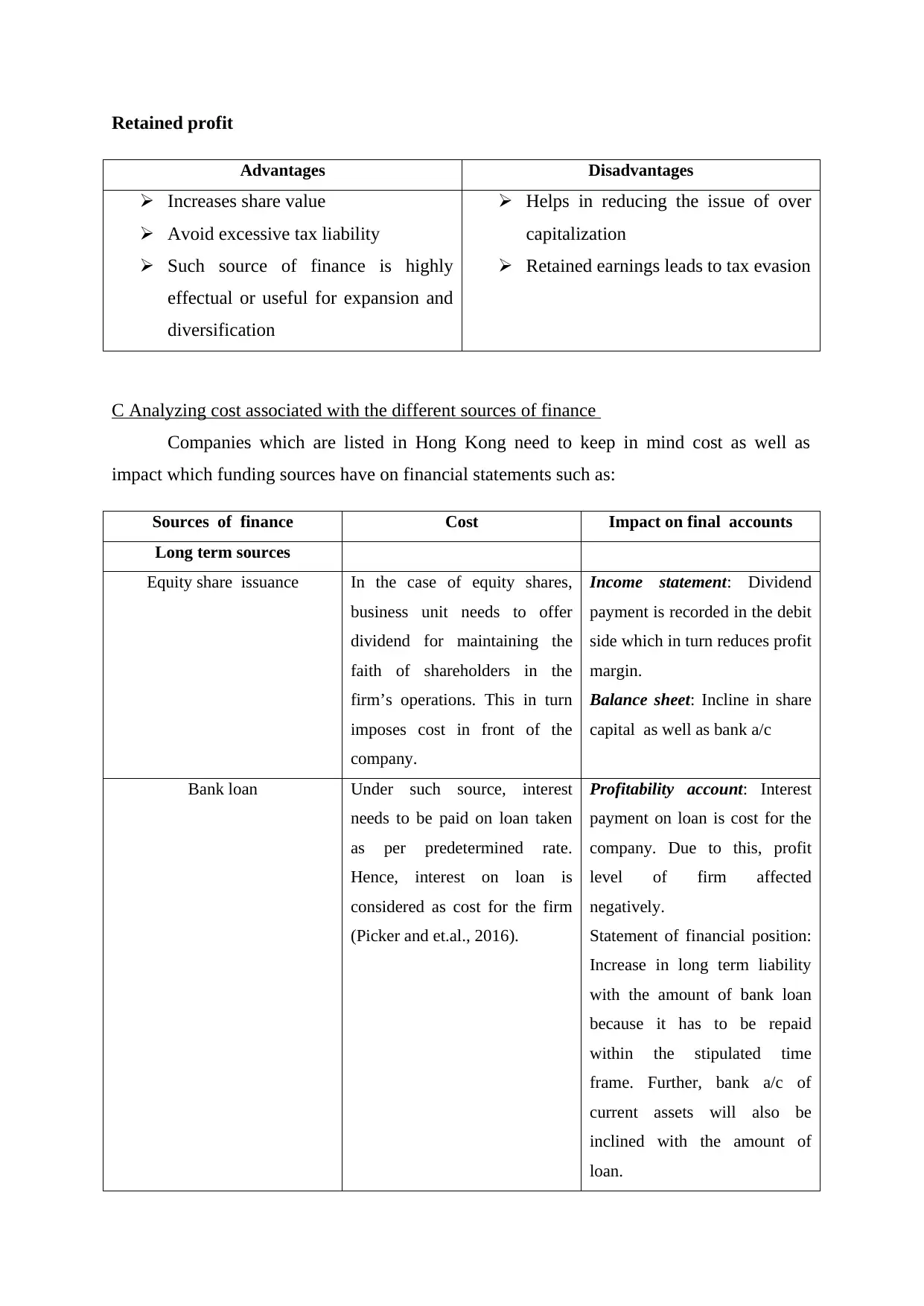
Retained profit
Advantages Disadvantages
Increases share value
Avoid excessive tax liability
Such source of finance is highly
effectual or useful for expansion and
diversification
Helps in reducing the issue of over
capitalization
Retained earnings leads to tax evasion
C Analyzing cost associated with the different sources of finance
Companies which are listed in Hong Kong need to keep in mind cost as well as
impact which funding sources have on financial statements such as:
Sources of finance Cost Impact on final accounts
Long term sources
Equity share issuance In the case of equity shares,
business unit needs to offer
dividend for maintaining the
faith of shareholders in the
firm’s operations. This in turn
imposes cost in front of the
company.
Income statement: Dividend
payment is recorded in the debit
side which in turn reduces profit
margin.
Balance sheet: Incline in share
capital as well as bank a/c
Bank loan Under such source, interest
needs to be paid on loan taken
as per predetermined rate.
Hence, interest on loan is
considered as cost for the firm
(Picker and et.al., 2016).
Profitability account: Interest
payment on loan is cost for the
company. Due to this, profit
level of firm affected
negatively.
Statement of financial position:
Increase in long term liability
with the amount of bank loan
because it has to be repaid
within the stipulated time
frame. Further, bank a/c of
current assets will also be
inclined with the amount of
loan.
Advantages Disadvantages
Increases share value
Avoid excessive tax liability
Such source of finance is highly
effectual or useful for expansion and
diversification
Helps in reducing the issue of over
capitalization
Retained earnings leads to tax evasion
C Analyzing cost associated with the different sources of finance
Companies which are listed in Hong Kong need to keep in mind cost as well as
impact which funding sources have on financial statements such as:
Sources of finance Cost Impact on final accounts
Long term sources
Equity share issuance In the case of equity shares,
business unit needs to offer
dividend for maintaining the
faith of shareholders in the
firm’s operations. This in turn
imposes cost in front of the
company.
Income statement: Dividend
payment is recorded in the debit
side which in turn reduces profit
margin.
Balance sheet: Incline in share
capital as well as bank a/c
Bank loan Under such source, interest
needs to be paid on loan taken
as per predetermined rate.
Hence, interest on loan is
considered as cost for the firm
(Picker and et.al., 2016).
Profitability account: Interest
payment on loan is cost for the
company. Due to this, profit
level of firm affected
negatively.
Statement of financial position:
Increase in long term liability
with the amount of bank loan
because it has to be repaid
within the stipulated time
frame. Further, bank a/c of
current assets will also be
inclined with the amount of
loan.
⊘ This is a preview!⊘
Do you want full access?
Subscribe today to unlock all pages.

Trusted by 1+ million students worldwide
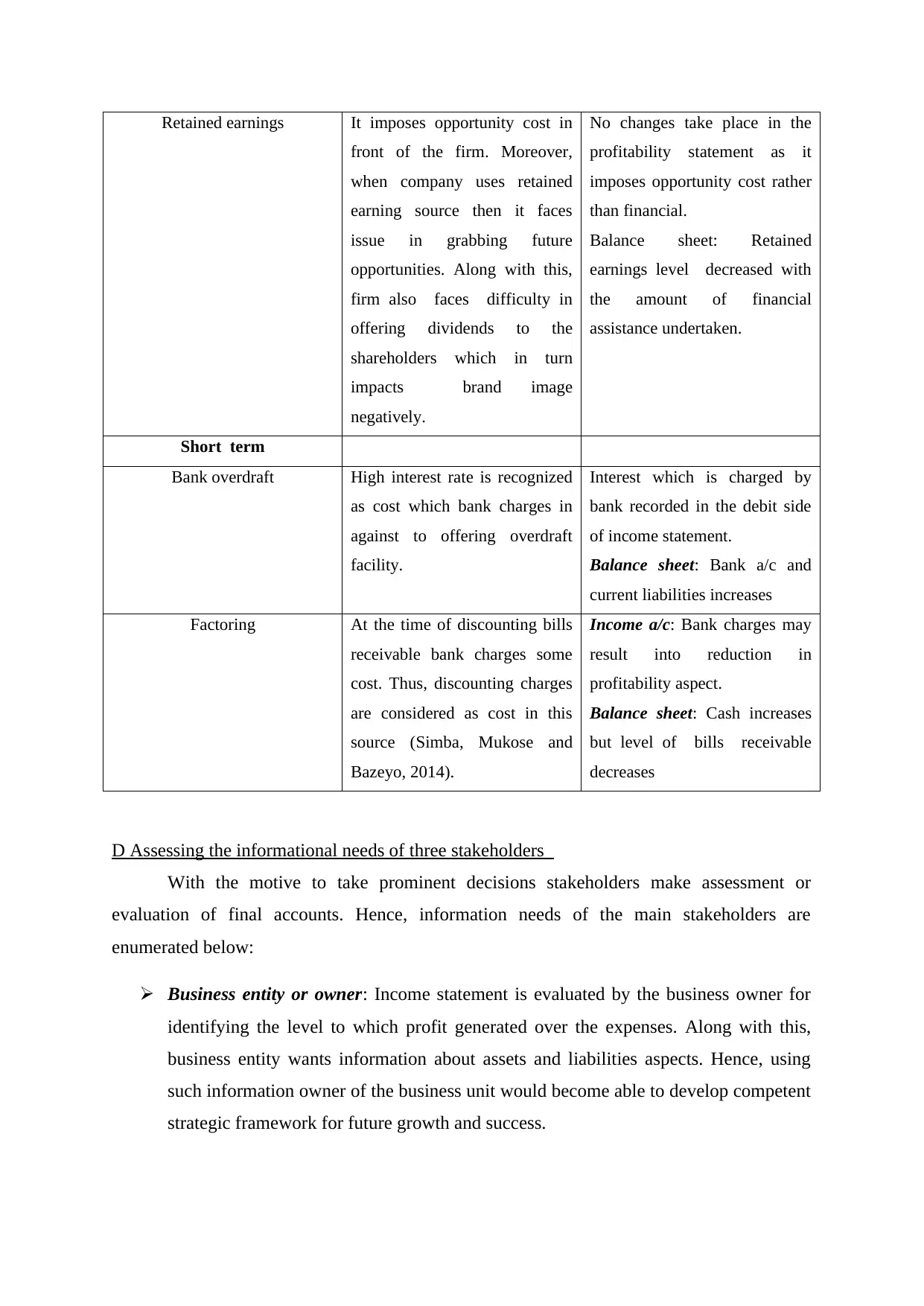
Retained earnings It imposes opportunity cost in
front of the firm. Moreover,
when company uses retained
earning source then it faces
issue in grabbing future
opportunities. Along with this,
firm also faces difficulty in
offering dividends to the
shareholders which in turn
impacts brand image
negatively.
No changes take place in the
profitability statement as it
imposes opportunity cost rather
than financial.
Balance sheet: Retained
earnings level decreased with
the amount of financial
assistance undertaken.
Short term
Bank overdraft High interest rate is recognized
as cost which bank charges in
against to offering overdraft
facility.
Interest which is charged by
bank recorded in the debit side
of income statement.
Balance sheet: Bank a/c and
current liabilities increases
Factoring At the time of discounting bills
receivable bank charges some
cost. Thus, discounting charges
are considered as cost in this
source (Simba, Mukose and
Bazeyo, 2014).
Income a/c: Bank charges may
result into reduction in
profitability aspect.
Balance sheet: Cash increases
but level of bills receivable
decreases
D Assessing the informational needs of three stakeholders
With the motive to take prominent decisions stakeholders make assessment or
evaluation of final accounts. Hence, information needs of the main stakeholders are
enumerated below:
Business entity or owner: Income statement is evaluated by the business owner for
identifying the level to which profit generated over the expenses. Along with this,
business entity wants information about assets and liabilities aspects. Hence, using
such information owner of the business unit would become able to develop competent
strategic framework for future growth and success.
front of the firm. Moreover,
when company uses retained
earning source then it faces
issue in grabbing future
opportunities. Along with this,
firm also faces difficulty in
offering dividends to the
shareholders which in turn
impacts brand image
negatively.
No changes take place in the
profitability statement as it
imposes opportunity cost rather
than financial.
Balance sheet: Retained
earnings level decreased with
the amount of financial
assistance undertaken.
Short term
Bank overdraft High interest rate is recognized
as cost which bank charges in
against to offering overdraft
facility.
Interest which is charged by
bank recorded in the debit side
of income statement.
Balance sheet: Bank a/c and
current liabilities increases
Factoring At the time of discounting bills
receivable bank charges some
cost. Thus, discounting charges
are considered as cost in this
source (Simba, Mukose and
Bazeyo, 2014).
Income a/c: Bank charges may
result into reduction in
profitability aspect.
Balance sheet: Cash increases
but level of bills receivable
decreases
D Assessing the informational needs of three stakeholders
With the motive to take prominent decisions stakeholders make assessment or
evaluation of final accounts. Hence, information needs of the main stakeholders are
enumerated below:
Business entity or owner: Income statement is evaluated by the business owner for
identifying the level to which profit generated over the expenses. Along with this,
business entity wants information about assets and liabilities aspects. Hence, using
such information owner of the business unit would become able to develop competent
strategic framework for future growth and success.
Paraphrase This Document
Need a fresh take? Get an instant paraphrase of this document with our AI Paraphraser
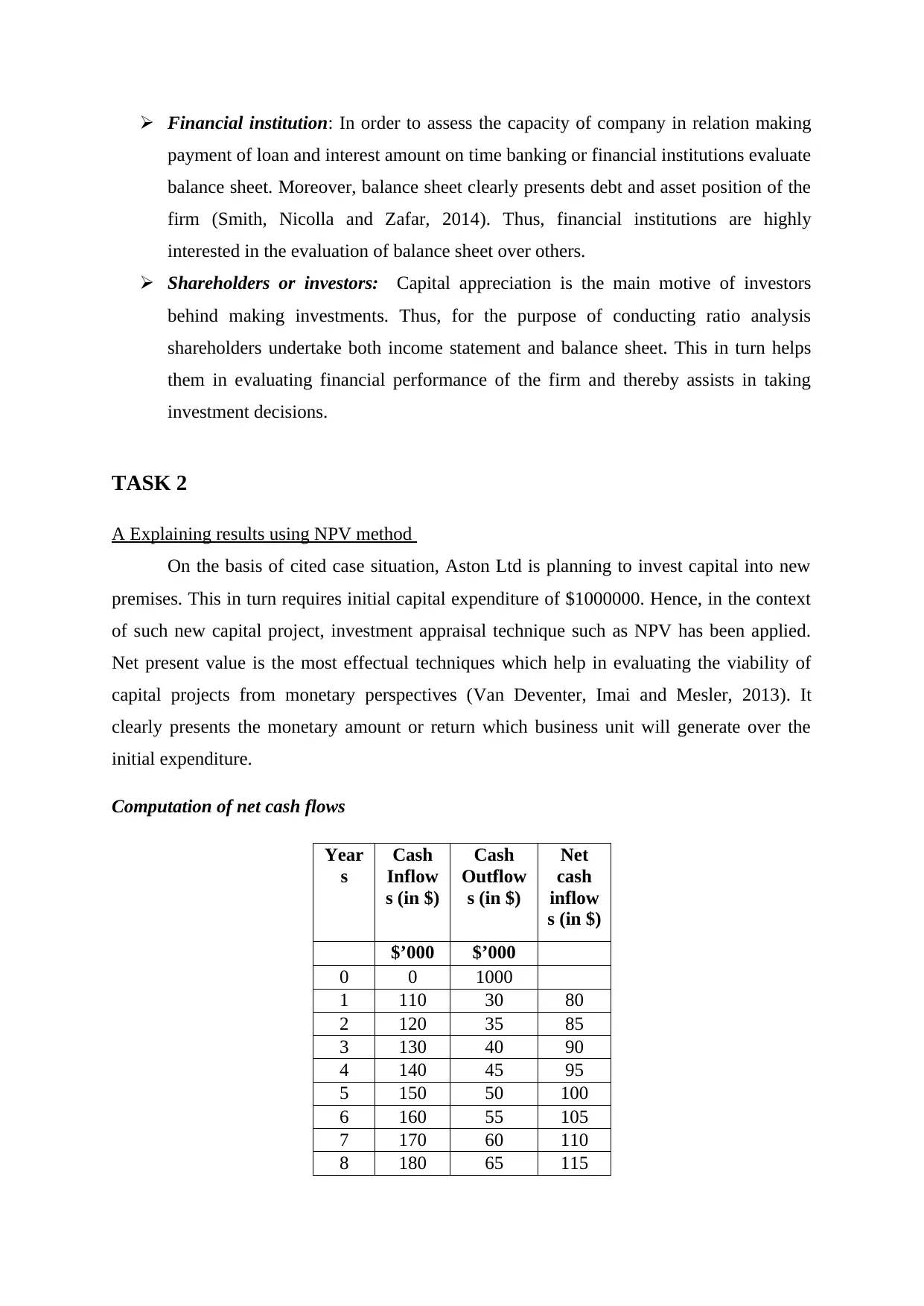
Financial institution: In order to assess the capacity of company in relation making
payment of loan and interest amount on time banking or financial institutions evaluate
balance sheet. Moreover, balance sheet clearly presents debt and asset position of the
firm (Smith, Nicolla and Zafar, 2014). Thus, financial institutions are highly
interested in the evaluation of balance sheet over others.
Shareholders or investors: Capital appreciation is the main motive of investors
behind making investments. Thus, for the purpose of conducting ratio analysis
shareholders undertake both income statement and balance sheet. This in turn helps
them in evaluating financial performance of the firm and thereby assists in taking
investment decisions.
TASK 2
A Explaining results using NPV method
On the basis of cited case situation, Aston Ltd is planning to invest capital into new
premises. This in turn requires initial capital expenditure of $1000000. Hence, in the context
of such new capital project, investment appraisal technique such as NPV has been applied.
Net present value is the most effectual techniques which help in evaluating the viability of
capital projects from monetary perspectives (Van Deventer, Imai and Mesler, 2013). It
clearly presents the monetary amount or return which business unit will generate over the
initial expenditure.
Computation of net cash flows
Year
s
Cash
Inflow
s (in $)
Cash
Outflow
s (in $)
Net
cash
inflow
s (in $)
$’000 $’000
0 0 1000
1 110 30 80
2 120 35 85
3 130 40 90
4 140 45 95
5 150 50 100
6 160 55 105
7 170 60 110
8 180 65 115
payment of loan and interest amount on time banking or financial institutions evaluate
balance sheet. Moreover, balance sheet clearly presents debt and asset position of the
firm (Smith, Nicolla and Zafar, 2014). Thus, financial institutions are highly
interested in the evaluation of balance sheet over others.
Shareholders or investors: Capital appreciation is the main motive of investors
behind making investments. Thus, for the purpose of conducting ratio analysis
shareholders undertake both income statement and balance sheet. This in turn helps
them in evaluating financial performance of the firm and thereby assists in taking
investment decisions.
TASK 2
A Explaining results using NPV method
On the basis of cited case situation, Aston Ltd is planning to invest capital into new
premises. This in turn requires initial capital expenditure of $1000000. Hence, in the context
of such new capital project, investment appraisal technique such as NPV has been applied.
Net present value is the most effectual techniques which help in evaluating the viability of
capital projects from monetary perspectives (Van Deventer, Imai and Mesler, 2013). It
clearly presents the monetary amount or return which business unit will generate over the
initial expenditure.
Computation of net cash flows
Year
s
Cash
Inflow
s (in $)
Cash
Outflow
s (in $)
Net
cash
inflow
s (in $)
$’000 $’000
0 0 1000
1 110 30 80
2 120 35 85
3 130 40 90
4 140 45 95
5 150 50 100
6 160 55 105
7 170 60 110
8 180 65 115
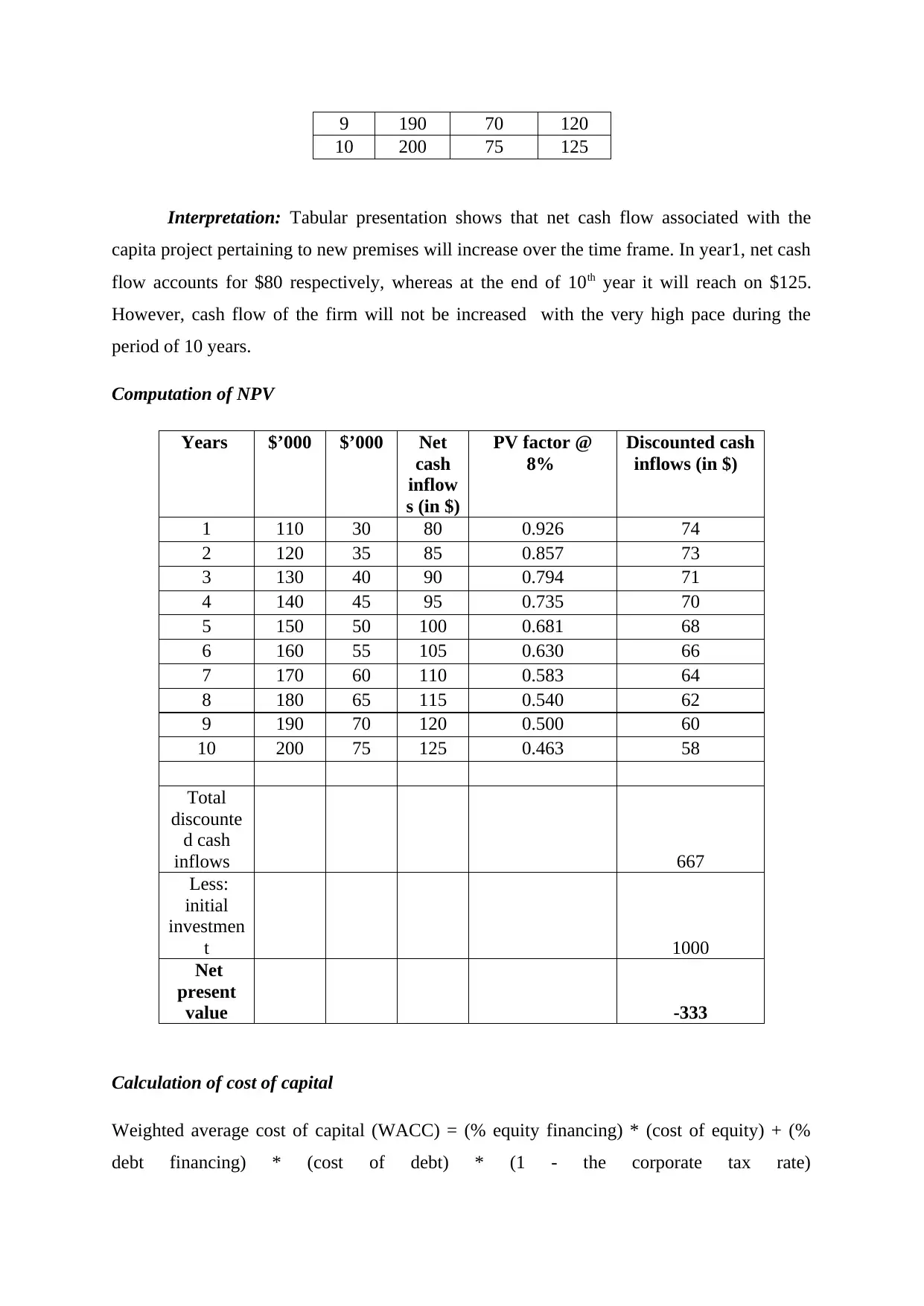
9 190 70 120
10 200 75 125
Interpretation: Tabular presentation shows that net cash flow associated with the
capita project pertaining to new premises will increase over the time frame. In year1, net cash
flow accounts for $80 respectively, whereas at the end of 10th year it will reach on $125.
However, cash flow of the firm will not be increased with the very high pace during the
period of 10 years.
Computation of NPV
Years $’000 $’000 Net
cash
inflow
s (in $)
PV factor @
8%
Discounted cash
inflows (in $)
1 110 30 80 0.926 74
2 120 35 85 0.857 73
3 130 40 90 0.794 71
4 140 45 95 0.735 70
5 150 50 100 0.681 68
6 160 55 105 0.630 66
7 170 60 110 0.583 64
8 180 65 115 0.540 62
9 190 70 120 0.500 60
10 200 75 125 0.463 58
Total
discounte
d cash
inflows 667
Less:
initial
investmen
t 1000
Net
present
value -333
Calculation of cost of capital
Weighted average cost of capital (WACC) = (% equity financing) * (cost of equity) + (%
debt financing) * (cost of debt) * (1 - the corporate tax rate)
10 200 75 125
Interpretation: Tabular presentation shows that net cash flow associated with the
capita project pertaining to new premises will increase over the time frame. In year1, net cash
flow accounts for $80 respectively, whereas at the end of 10th year it will reach on $125.
However, cash flow of the firm will not be increased with the very high pace during the
period of 10 years.
Computation of NPV
Years $’000 $’000 Net
cash
inflow
s (in $)
PV factor @
8%
Discounted cash
inflows (in $)
1 110 30 80 0.926 74
2 120 35 85 0.857 73
3 130 40 90 0.794 71
4 140 45 95 0.735 70
5 150 50 100 0.681 68
6 160 55 105 0.630 66
7 170 60 110 0.583 64
8 180 65 115 0.540 62
9 190 70 120 0.500 60
10 200 75 125 0.463 58
Total
discounte
d cash
inflows 667
Less:
initial
investmen
t 1000
Net
present
value -333
Calculation of cost of capital
Weighted average cost of capital (WACC) = (% equity financing) * (cost of equity) + (%
debt financing) * (cost of debt) * (1 - the corporate tax rate)
⊘ This is a preview!⊘
Do you want full access?
Subscribe today to unlock all pages.

Trusted by 1+ million students worldwide
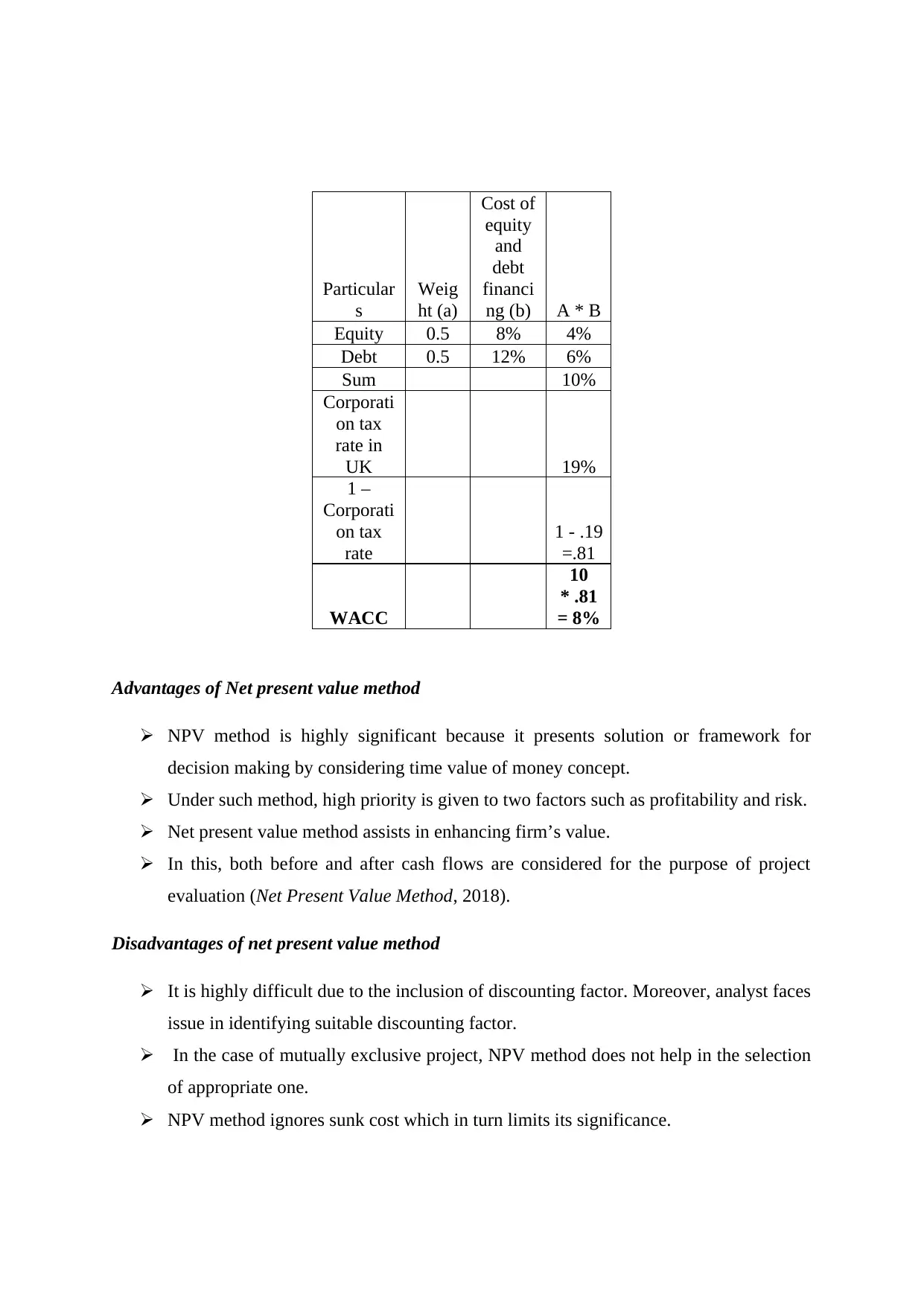
Particular
s
Weig
ht (a)
Cost of
equity
and
debt
financi
ng (b) A * B
Equity 0.5 8% 4%
Debt 0.5 12% 6%
Sum 10%
Corporati
on tax
rate in
UK 19%
1 –
Corporati
on tax
rate
1 - .19
=.81
WACC
10
* .81
= 8%
Advantages of Net present value method
NPV method is highly significant because it presents solution or framework for
decision making by considering time value of money concept.
Under such method, high priority is given to two factors such as profitability and risk.
Net present value method assists in enhancing firm’s value.
In this, both before and after cash flows are considered for the purpose of project
evaluation (Net Present Value Method, 2018).
Disadvantages of net present value method
It is highly difficult due to the inclusion of discounting factor. Moreover, analyst faces
issue in identifying suitable discounting factor.
In the case of mutually exclusive project, NPV method does not help in the selection
of appropriate one.
NPV method ignores sunk cost which in turn limits its significance.
s
Weig
ht (a)
Cost of
equity
and
debt
financi
ng (b) A * B
Equity 0.5 8% 4%
Debt 0.5 12% 6%
Sum 10%
Corporati
on tax
rate in
UK 19%
1 –
Corporati
on tax
rate
1 - .19
=.81
WACC
10
* .81
= 8%
Advantages of Net present value method
NPV method is highly significant because it presents solution or framework for
decision making by considering time value of money concept.
Under such method, high priority is given to two factors such as profitability and risk.
Net present value method assists in enhancing firm’s value.
In this, both before and after cash flows are considered for the purpose of project
evaluation (Net Present Value Method, 2018).
Disadvantages of net present value method
It is highly difficult due to the inclusion of discounting factor. Moreover, analyst faces
issue in identifying suitable discounting factor.
In the case of mutually exclusive project, NPV method does not help in the selection
of appropriate one.
NPV method ignores sunk cost which in turn limits its significance.
Paraphrase This Document
Need a fresh take? Get an instant paraphrase of this document with our AI Paraphraser
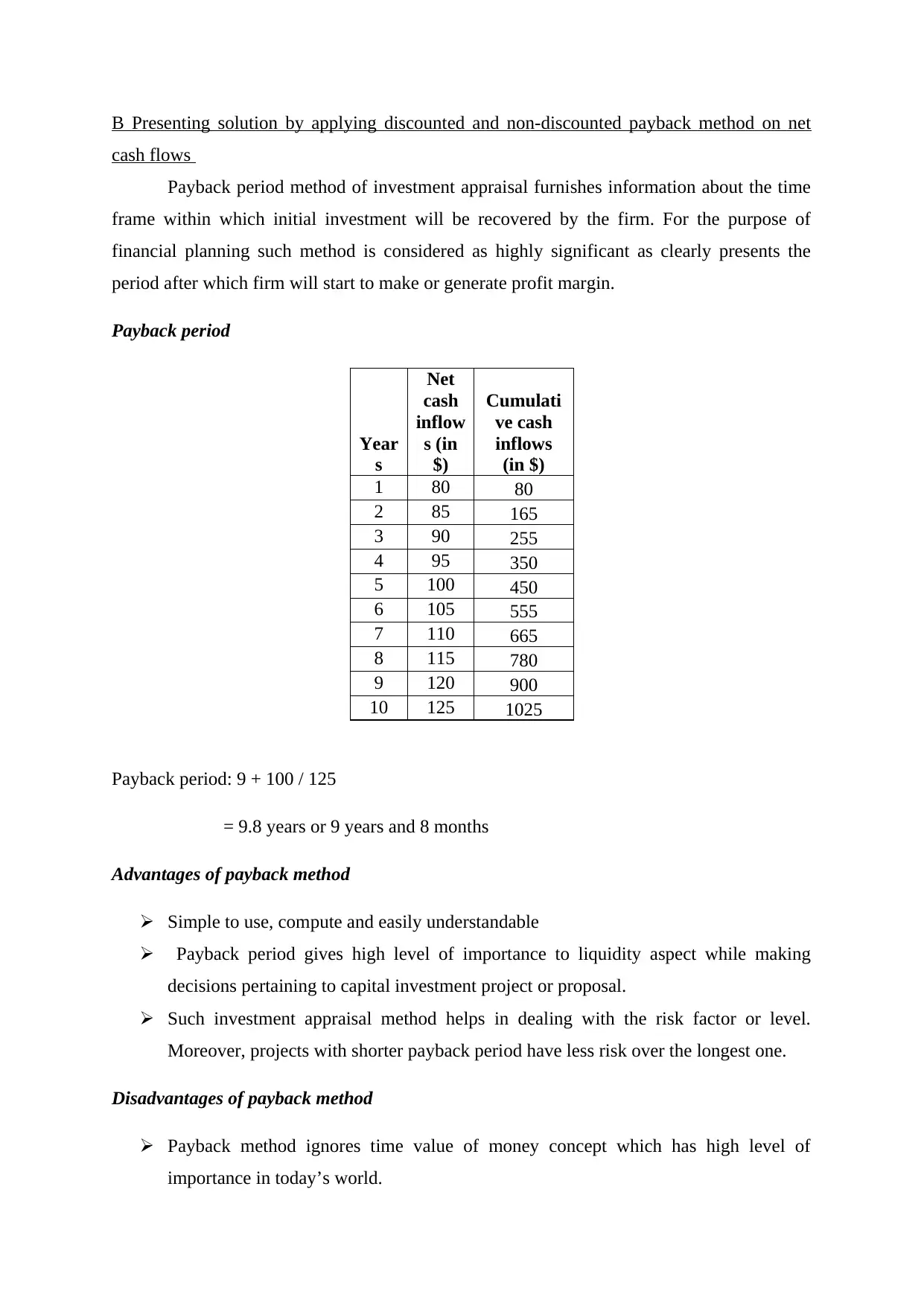
B Presenting solution by applying discounted and non-discounted payback method on net
cash flows
Payback period method of investment appraisal furnishes information about the time
frame within which initial investment will be recovered by the firm. For the purpose of
financial planning such method is considered as highly significant as clearly presents the
period after which firm will start to make or generate profit margin.
Payback period
Year
s
Net
cash
inflow
s (in
$)
Cumulati
ve cash
inflows
(in $)
1 80 80
2 85 165
3 90 255
4 95 350
5 100 450
6 105 555
7 110 665
8 115 780
9 120 900
10 125 1025
Payback period: 9 + 100 / 125
= 9.8 years or 9 years and 8 months
Advantages of payback method
Simple to use, compute and easily understandable
Payback period gives high level of importance to liquidity aspect while making
decisions pertaining to capital investment project or proposal.
Such investment appraisal method helps in dealing with the risk factor or level.
Moreover, projects with shorter payback period have less risk over the longest one.
Disadvantages of payback method
Payback method ignores time value of money concept which has high level of
importance in today’s world.
cash flows
Payback period method of investment appraisal furnishes information about the time
frame within which initial investment will be recovered by the firm. For the purpose of
financial planning such method is considered as highly significant as clearly presents the
period after which firm will start to make or generate profit margin.
Payback period
Year
s
Net
cash
inflow
s (in
$)
Cumulati
ve cash
inflows
(in $)
1 80 80
2 85 165
3 90 255
4 95 350
5 100 450
6 105 555
7 110 665
8 115 780
9 120 900
10 125 1025
Payback period: 9 + 100 / 125
= 9.8 years or 9 years and 8 months
Advantages of payback method
Simple to use, compute and easily understandable
Payback period gives high level of importance to liquidity aspect while making
decisions pertaining to capital investment project or proposal.
Such investment appraisal method helps in dealing with the risk factor or level.
Moreover, projects with shorter payback period have less risk over the longest one.
Disadvantages of payback method
Payback method ignores time value of money concept which has high level of
importance in today’s world.
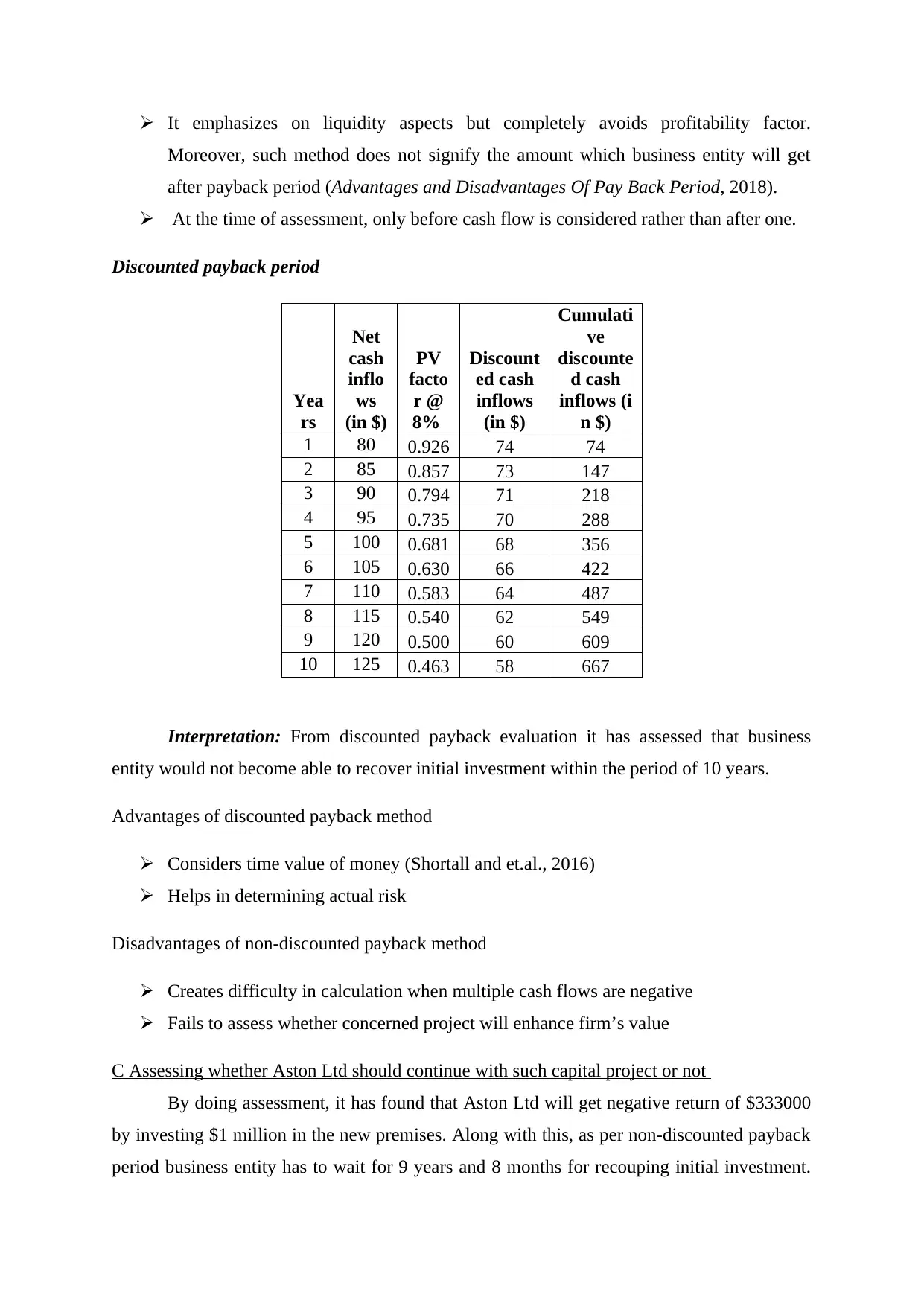
It emphasizes on liquidity aspects but completely avoids profitability factor.
Moreover, such method does not signify the amount which business entity will get
after payback period (Advantages and Disadvantages Of Pay Back Period, 2018).
At the time of assessment, only before cash flow is considered rather than after one.
Discounted payback period
Yea
rs
Net
cash
inflo
ws
(in $)
PV
facto
r @
8%
Discount
ed cash
inflows
(in $)
Cumulati
ve
discounte
d cash
inflows (i
n $)
1 80 0.926 74 74
2 85 0.857 73 147
3 90 0.794 71 218
4 95 0.735 70 288
5 100 0.681 68 356
6 105 0.630 66 422
7 110 0.583 64 487
8 115 0.540 62 549
9 120 0.500 60 609
10 125 0.463 58 667
Interpretation: From discounted payback evaluation it has assessed that business
entity would not become able to recover initial investment within the period of 10 years.
Advantages of discounted payback method
Considers time value of money (Shortall and et.al., 2016)
Helps in determining actual risk
Disadvantages of non-discounted payback method
Creates difficulty in calculation when multiple cash flows are negative
Fails to assess whether concerned project will enhance firm’s value
C Assessing whether Aston Ltd should continue with such capital project or not
By doing assessment, it has found that Aston Ltd will get negative return of $333000
by investing $1 million in the new premises. Along with this, as per non-discounted payback
period business entity has to wait for 9 years and 8 months for recouping initial investment.
Moreover, such method does not signify the amount which business entity will get
after payback period (Advantages and Disadvantages Of Pay Back Period, 2018).
At the time of assessment, only before cash flow is considered rather than after one.
Discounted payback period
Yea
rs
Net
cash
inflo
ws
(in $)
PV
facto
r @
8%
Discount
ed cash
inflows
(in $)
Cumulati
ve
discounte
d cash
inflows (i
n $)
1 80 0.926 74 74
2 85 0.857 73 147
3 90 0.794 71 218
4 95 0.735 70 288
5 100 0.681 68 356
6 105 0.630 66 422
7 110 0.583 64 487
8 115 0.540 62 549
9 120 0.500 60 609
10 125 0.463 58 667
Interpretation: From discounted payback evaluation it has assessed that business
entity would not become able to recover initial investment within the period of 10 years.
Advantages of discounted payback method
Considers time value of money (Shortall and et.al., 2016)
Helps in determining actual risk
Disadvantages of non-discounted payback method
Creates difficulty in calculation when multiple cash flows are negative
Fails to assess whether concerned project will enhance firm’s value
C Assessing whether Aston Ltd should continue with such capital project or not
By doing assessment, it has found that Aston Ltd will get negative return of $333000
by investing $1 million in the new premises. Along with this, as per non-discounted payback
period business entity has to wait for 9 years and 8 months for recouping initial investment.
⊘ This is a preview!⊘
Do you want full access?
Subscribe today to unlock all pages.

Trusted by 1+ million students worldwide
1 out of 18
Related Documents
Your All-in-One AI-Powered Toolkit for Academic Success.
+13062052269
info@desklib.com
Available 24*7 on WhatsApp / Email
![[object Object]](/_next/static/media/star-bottom.7253800d.svg)
Unlock your academic potential
Copyright © 2020–2025 A2Z Services. All Rights Reserved. Developed and managed by ZUCOL.





